Abstract
A renewable energy source that is important for human daily task performance is daylighting according to photobiologist. These daily task requires visual comfort for optimal performance such as writing and reading. These tasks are also commonly performed as educational process in learning spaces such as classrooms. Various research shows that the improvement of students’ performance can be highly influenced by the improvement of daylighting as well. Learning spaces requires illuminance level between 300lux to 500lux based on recommendations in various standards and guidelines. Recent increment of more than 900 religious school establishment shows that the demand for Ulul Albab education among Malaysians increases since 2011. Tasmi’ is one of the method used for Quran ‘hafazan’ (memorization) learning process as a part of Ulul Albab education. Kolej Permata Insan has adapted the Tasmi’ method in their Ulul Albab education and as far as designing a Tasmi’ classroom specifically for Quran ‘hafazan’ teaching. However, since the learning process follows a tradition of using a book rest or ‘rehal’, the illuminance level required for visual comfort and optimum learning task performance in the Tasmi’ classrooms differs. The main focus of this research is to evaluate the students’ perceptions on the daylight condition in the Tasmi’ classrooms through data collected from the provided questionnaire. Results shows that all of the classrooms exceeds the recommended illuminance level. Thus, this reduces the students’ visual comfort based on the result of the questionnaire on the students’ perception. Further study for Tasmi’ acceptable illuminance level is required.
Keywords: Illuminance level, daylighting, Tasmi' classroom, students' perception
Introduction
Historical development of learning spaces design in 19th century influenced by the development of certain knowledge area such as construction, technologies, policies, systems and many others. Robson (1874) coined the term ‘School House’ for a single room building that serves as a space for a typical education system. Afterwards, assimilation between a larger institutional bodies such as churches seen as a viable decision due the availability of spaces and increment of students enrolled. Church’s hall and community hall were used as one huge classroom (Wu & Ng, 2003). However, since the introduction of specific education system, school designs have few smaller and separated classrooms in a single building. This caters for various education such as religious studies. This can be exemplified with the development of education during Seljuq Dynasty in the 10th century, where the two identity of institution is separated from each other. Religious institution such as mosques were separated with learning institution such as madrasa or schools (Fuady, 2015). Kolej Permata Insan in Nilai has a classroom designed specifically for Ulul Albab education which emphasises the Quran teachings such as ‘hafazan’ (memorization). The classroom design for specific education and task should consider the cognitive skills, health and psychology of the students due to its effect towards the students’ performance. One of the consideration that improves the students’ cognitive skills, health and psychology that increases the students’ performance is daylighting (Mirrahimi, Ibrahim, & Surat, 2013).
Problem Statement
The Tasmi’ classrooms in Kolej Permata Insan is used for ‘hafazan’ learning tasks, which requires the students to use ‘rehal’ that have lower working plane height compared to a normal table. The difference of working plane height influences the average illuminance level receive, thus influences the students’ tasks performance as well as the students’ visual comfort.
Research Questions
The research question for this study includes:
- How is the layout and design of the selected Tasmi’ classroom?
- How much is the average illuminance level received in the Tasmi’ classroom?
- What is the students’ perception on daylight condition in Tasmi’ classroom?
Purpose of the Study
The purpose of the study is to look into the students’ perception on daylight condition of classrooms that is used for specific learning tasks using in different setup, which are ‘hafazan’ learning tasks and the working plane height respectively. This perception is related to the students’ task performance and visual comfort. Understanding the students’ perception as mentioned leads to different classroom layout design suitable for different learning task requirement.
Research Methods
This study includes a filed measurement to identify the size and dimensions of the Tasmi’ classroom layout design selected in Kolej Permata Insan. The size and dimension of the classroom identifies the suitable numbers of students in the classroom based on the requirement by Guidelines and Regulations for Building Planning (GRBP) stating that each student allocation of area is 2.5m2. The selected Tasmi’ classroom is 3m x 3m with total area of 9m2 as shown in Figure 1 below.
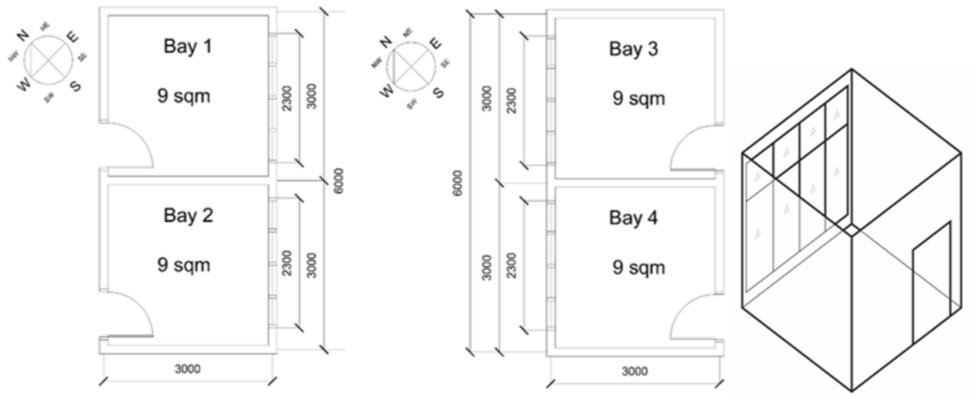
The Window-to-Floor Ratio (WFR) of the Tasmi’ classrooms were controlled at 20% based on MS1525 standards as shown in Figure 2 below. The total students that occupied each classroom were three students. The students were required to use bookstand or ‘rehal’ during the data collection to simulate the traditional ‘hafazan’ teaching and learning. The classroom located on the ground floor with no immediate obstacle or obstruction for daylight and view to the outside. The window sill height of the classroom measured at 300mm high, similarly with the ‘rehal’ working plane height.
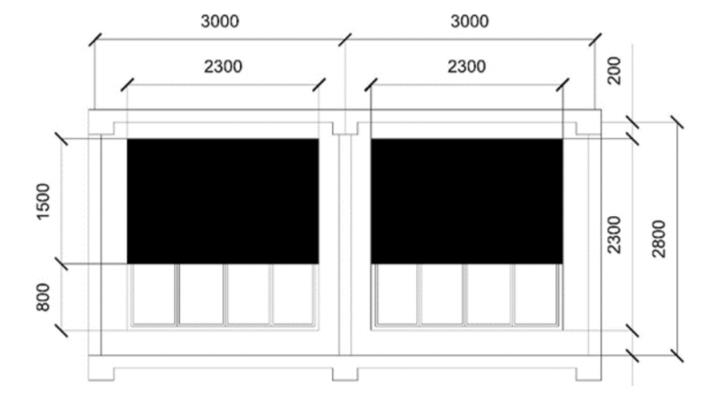
The average illuminance level was recorded for each classroom. The second stage of the study required the questionnaire based on the students’ Daylight Condition Perception that has been structured with five level Likert Scale. Descriptive analysis of the questionnaire using SPSS 25 identifies the students’ perception on the daylight condition of each Tasmi’ classroom based on the measured illuminance level.
Tasmi’s classroom illuminance level
The illuminance level measuring tool were placed in the Tasmi’ classrooms 1meter apart from each other. The measuring tools were placed at ‘rehal’ 300mm working plane height to measure the average illuminance level. The average illuminance level for each classroom as shown in Figure 3 below. The illuminance level was recorded with the students occupying the classroom to measure the actual daylight due to daylight fluctuation (Elina, 2016).
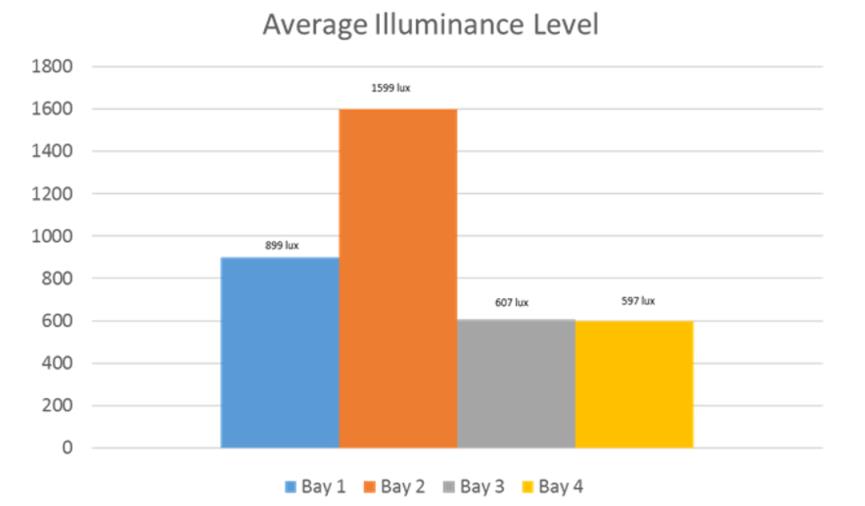
The average illuminance level measured in each Tasmi’ classroom exceeded the recommended value between 300 lux to 500 lux, based on standards and guidelines when measured at ‘rehal’ 300mm working plane height. In theory, the Tasmi’ classrooms in Kolej Permata Insan were not suitable for learning tasks that involves specific task, even though the WFR were kept constant following the recommended value of 20% by standards and guidelines. Average illuminance level higher than recommended creates glare and eye discomfort to the occupants. However, this result was compared with the students’ Daylight Condition Perception questionnaire results to identify the actual perception of the students in the classrooms with higher illuminance level.
Daylight Condition Perception Questionnaire
The questionnaire provided during the data collection was structured to identify the students’ Daylight Condition Perception in the Tasmi’ classroom. The component consists of three variables which was adapted from various daylighting studies such as Hirning et al. (2016) and Cauwerts, Piderit, and Diaz, (2014) as shown in Figure 4 below. Principal Component Analysis (PCA) is used to identify the variables that were related in a single component.
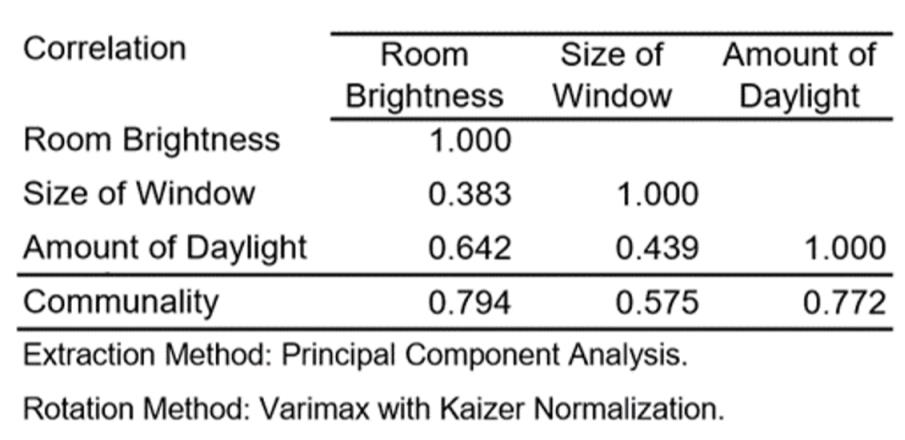
Each variable was measured using five scale Likert scale type questionnaire ranging from 1=lowest to 5=highest perception. The correlation value for the three variables is lower than 1. This shows that each variables correlation between each other is low. The communality of each variable has values higher than 0.4, where Child (2006) and Yong and Pearce (2013) mentioned to omit any variables with the communality score below than 0.2.
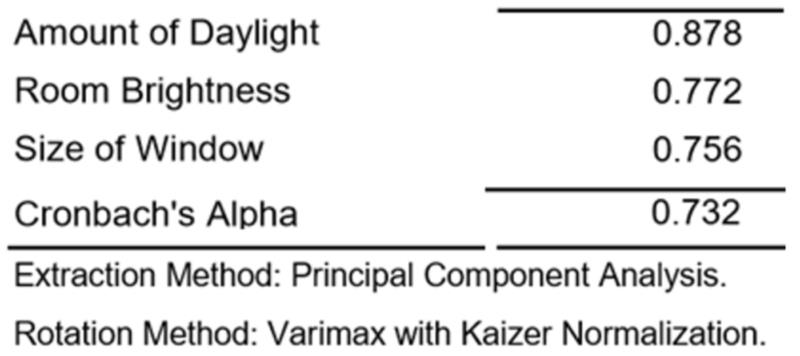
Figure 5 above shows the Rotated Component Matrixa for each variables are 0.878, 0.772 and 0.756 respectively, which are higher than trivial value of 0.3 or 0.4. The Cronbach’s Alpha value of 0.732 is reliable where it is higher than 7.0. The students in each Tasmi’ classrooms are required to answer the questionnaire within 20 minutes of the data collection session.
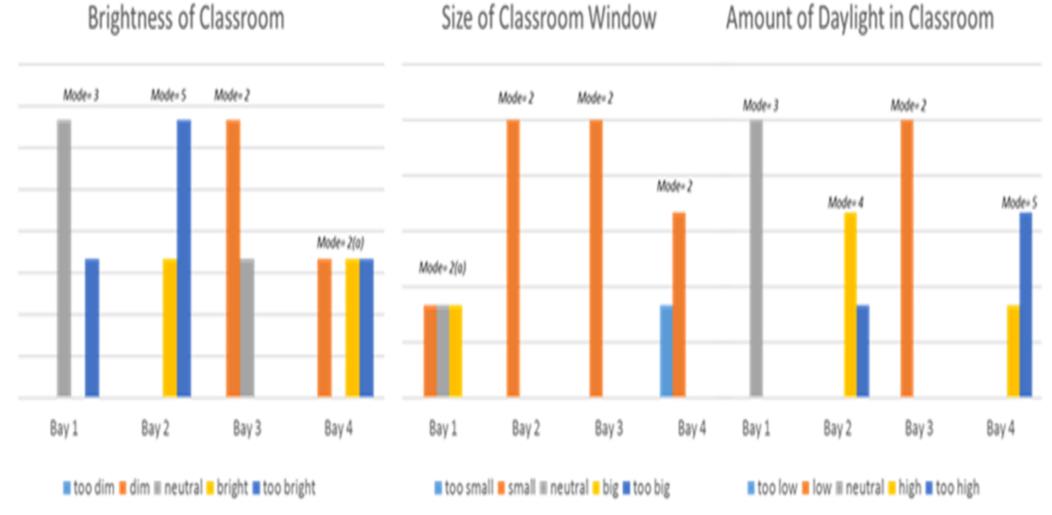
Figure 6 above shows that Bay 1 students perceived the brightness of classroom as 3=neutral/normal, 5=too bright in Bay 2, 2=dim in Bay 3 and undecided in Bay 4 with the lowest Mode of 2=dim. The size of classroom window in Bay 1 is undecided with lowest Mode of 2=small and all other bays perceived as having 2=small window size. The students in Bay 1 perceived the amount of daylight in the classroom is 3=neutral/normal. Bay 2 students perceived it as 4=high, Bay 3 students perceived as 2=low and Bay 4 perceived the amount of daylight as 5=too high. These results are compared with each Tasmi’ classroom average illuminance level.
Findings
The comparison of the Tasmi’ classrooms average illuminance level and the students’ Daylight Condition Perceptions questionnaire results can identify the Tasmi’ classroom layout design in Kolej Permata Insan to be suitable or not for ‘hafazan’ learning task through the students’ perception. Table 1 shows the results for both average illuminance level and students ‘perception for each Tasmi’ classrooms.
The students’ perception on Daylight Condition in Tasmi’ classroom Bay 1 is that the classroom has normal brightness and amount of daylight, thus suitable and comfortable for ‘hafazan’ learning task even though the average illuminance level is almost double higher than recommended in standards and guidelines. Tasmi’ classroom Bay 2 is obviously not suitable for ‘hafazan’ learning task due to its average illuminance is too high with 1599 lux, which agreed by the students with the brightness too bright and daylight amount is high, although the students perceive the window size is small. Although the average illuminance level measured in Bay 3 is slightly higher than recommended, the students’ perception is that the Tasmi’ classroom is dim and the daylight amount is low, in line with the students’ perception of the window size is small. Slightly higher than recommended illuminance level of 597 lux, students in Bay 4 perceived the window size is small even though they perceived the brightness as between dim to too high and the daylight amount is too high.
Conclusion
The result of the research shows that the range of acceptable illuminance level for students’ ‘hafazan’ learning task measured at ‘rehal’ 300mm working plane height in a classroom with 300mm window sill height requires further in depth studies. This can be said due to the students’ perception in the research shows that slightly higher average illuminance level between 500 lux to 600 lux measured at 300mm working plane seem to be acceptable by the students’ perception. This research also shows that illuminance level measured at a lower working plane height is with different results and influences the students’ perception on the daylight condition, thus influences the students’ ‘hafazan’ learning task performance. Further study is required to expand the understanding and knowledge of daylighting in Ulul Albab based education that uses different teaching tools and facilities.
Acknowledgments
This paper is under the special grant Mizan Solar Home Model for Sustainable Livelihood, (PPP/KHAS_FKAB/30/10117) Universiti Sains Islam Malaysia (USIM), Nilai, Negeri Sembilan.
References
Cauwerts, C., Piderit, M. B., & Diaz, M. (2014). Definition of the CIE standard skies and application of high dynamic range imaging technique to characterize the spatial distribution of daylight in Chile. Journal of Construction, 13(2), 22-30.
Child, D. (2006). The Essentials of Factor Analysis. A&C Black Publisher.
Elina, M. H. (2016). Occupant density and daylight illuminance level fluctuation for office building in Malaysia. (PhD thesis). Universiti Teknologi Malaysia, Faculty of Built Environment.
Fuady, M. N. (2015). Sistem dan Kelembagaan Pendidikan Islam Bani Saljuk, Tarbiyah Islamiyah. Jurnal Ilmiah Pendidikan Agama Islam, 5(2), 20-42.
Hirning, M. B., Lim, G. H., & Reimann, G. P. (2016). Discomfort Glare in Energy Efficient Buildings: A Case Study in the Malaysian Context. In Proceedings of Lighting Quality and Energy Efficiency, 212 – 223. ISBN 978-3-902842-65-7
Mirrahimi, S., Ibrahim, N. L. N., & Surat, M. (2013). Estimation Daylight to Find Simple Formulate Based on the Ratio of Window Area to Floor Area Rule of Thumb for Classroom in Malaysia. Research Journal of Applied Sciences, Engineering and Technology, 6, 931-93.
Robson, E. R. (1874). School Architecture: Being Practical Remarks On the Planning, Designing, Building, and Furnishing of School-Houses. London: J. Murray.
Wu, W., & Ng, E. (2003). A Review of the Development of Daylighting in Schools. Lighting Research Technology, 35(2), 111-125.
Yong, A. G., & Pearce, S. (2013). A Beginner’s Guide to Factor Analysis: Focusing on Exploratory Factor Analysis. Tutorials in Quantitative Methods for Psychology, 9(2), 79-94.
Copyright information

This work is licensed under a Creative Commons Attribution-NonCommercial-NoDerivatives 4.0 International License.
About this article
Publication Date
26 December 2017
Article Doi
eBook ISBN
978-1-80296-950-4
Publisher
Future Academy
Volume
2
Print ISBN (optional)
-
Edition Number
1st Edition
Pages
1-882
Subjects
Technology, smart cities, digital construction, industrial revolution 4.0, wellbeing & social resilience, economic resilience, environmental resilience
Cite this article as:
Arabi*, F., Husini, E. M., & Yazit, R. N. S. R. M. (2017). Students’ Daylight Condition Perception In Tasmi’ Classroom. In P. A. J. Wahid, P. I. D. A. Aziz Abdul Samad, P. D. S. Sheikh Ahmad, & A. P. D. P. Pujinda (Eds.), Carving The Future Built Environment: Environmental, Economic And Social Resilience, vol 2. European Proceedings of Multidisciplinary Sciences (pp. 301-307). Future Academy. https://doi.org/10.15405/epms.2019.12.29
